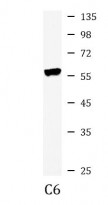ARG42876
anti-ATE1 antibody
anti-ATE1 antibody for Flow cytometry,IHC-Formalin-fixed paraffin-embedded sections,Western blot and Human,Mouse,Rat
Overview
| Product Description | Rabbit Polyclonal antibody recognizes ATE1 |
|---|---|
| Tested Reactivity | Hu, Ms, Rat |
| Tested Application | FACS, IHC-P, WB |
| Host | Rabbit |
| Clonality | Polyclonal |
| Isotype | IgG |
| Target Name | ATE1 |
| Antigen Species | Human |
| Immunogen | Synthetic peptide of Human ATE1. |
| Conjugation | Un-conjugated |
| Alternate Names | Arginine-tRNA--protein transferase 1; Arginyl-tRNA--protein transferase 1; EC 2.3.2.8; Arginyltransferase 1; R-transferase 1 |
Application Instructions
| Application Suggestion |
|
||||||||
|---|---|---|---|---|---|---|---|---|---|
| Application Note | * The dilutions indicate recommended starting dilutions and the optimal dilutions or concentrations should be determined by the scientist. | ||||||||
| Positive Control | C6 | ||||||||
| Observed Size | ~ 59 kDa |
Properties
| Form | Liquid |
|---|---|
| Purification | Affinity purified. |
| Buffer | 50 mM Tris-Glycine (pH 7.4), 150 mM NaCl, 0.01% Sodium azide, 40% Glycerol and 0.05% BSA. |
| Preservative | 0.01% Sodium azide |
| Stabilizer | 40% Glycerol and 0.05% BSA |
| Concentration | Batch dependent |
| Storage Instruction | For continuous use, store undiluted antibody at 2-8°C for up to a week. For long-term storage, aliquot and store at -20°C. Storage in frost free freezers is not recommended. Avoid repeated freeze/thaw cycles. Suggest spin the vial prior to opening. The antibody solution should be gently mixed before use. |
| Note | For laboratory research only, not for drug, diagnostic or other use. |
Bioinformation
| Database Links |
Swiss-port # O95260 Human Arginyl-tRNA--protein transferase 1 Swiss-port # Q9Z2A5 Mouse Arginyl-tRNA--protein transferase 1 |
|---|---|
| Gene Symbol | ATE1 |
| Gene Full Name | arginyltransferase 1 |
| Background | This gene encodes an arginyltransferase, an enzyme that is involved in posttranslational conjugation of arginine to N-terminal aspartate or glutamate residues. Conjugation of arginine to the N-terminal aspartate or glutamate targets proteins for ubiquitin-dependent degradation. Alternative splicing results in multiple transcript variants. [provided by RefSeq, Dec 2013] |
| Function | Involved in the post-translational conjugation of arginine to the N-terminal aspartate or glutamate of a protein. This arginylation is required for degradation of the protein via the ubiquitin pathway. Does not arginylate cysteine residues (By similarity). [UniProt] |
| Cellular Localization | Isoform ATE1-1: Nucleus. Cytoplasm. Isoform ATE1-2: Cytoplasm. [UniProt] |
| Calculated MW | 59 kDa |
Images (1) Click the Picture to Zoom In






